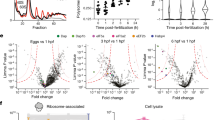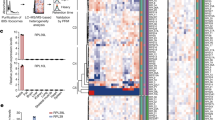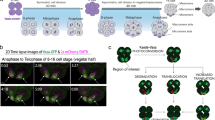Abstract
ELUCIDATION of the mechanisms involved in the cytoplasmic control of protein synthesis is essential for an understanding of the initiation of embryogenesis. On fertilisation, echinoid eggs increase their rate of protein synthesis many-fold, independent of any increase in ribosomal or mRNA synthesis1–4. Within 2 h of fertilisation the number of ribosomes in polyribosomes increases about 25-fold without any change in the size distribution of poly ribosomes5,6. In addition, the polyribosome number doubles again by gastrulation. However, the total rate of protein synthesis increases 113-fold from egg to gastrulation7. The discrepancy between the number of ribosomes recruited into polyribosomes, an increase of ≈50 fold, and the total increase in the rate of protein synthesis, a 113-fold increase, could be explained if there were also an increase in the rate of movement of ribosomes along each message (elongation) and/or an increase in the rate of release of completed peptides (termination). We report here that the translational rate is increased about 2.5-fold after fertilisation in the sea urchin, Strongylocentrotus purpuratus. The average transit time (elongation plus termination time for an average-sized peptide) was measured for these eggs and several stages of embryos.
This is a preview of subscription content, access via your institution
Access options
Subscribe to this journal
Receive 51 print issues and online access
$199.00 per year
only $3.90 per issue
Buy this article
- Purchase on Springer Link
- Instant access to full article PDF
Prices may be subject to local taxes which are calculated during checkout
Similar content being viewed by others
References
Denny, P. C. & Tyler, A. Biochem. biophys. Res. Commun. 14, 245–249 (1964).
Gross, P. R., Malkin, L. I. & Moyer, W. A. Proc. natn. Acad. Sci. U.S.A. 51, 407–414 (1964).
Jenkins, N. A., Taylor, M. & Raff, R. A. Proc. natn. Acad. Sci. U.S.A. 70, 3287–3291 (1973).
Jenkins, N. A., Kaumeyer, J. F., Young, E. M. & Raff, R. A. Devl Biol. 63, 279–298 (1978).
Humphreys, T. Devl Biol. 26, 201–208 (1971).
Infante, A. A. & Nemer, M. Proc. natn. Acad. Sci. U.S.A. 58, 681–688 (1967).
Regier, J. C. & Kafatos, F. C. Devl Biol. 57, 270–283 (1977).
Fan, J. & Penman, S. J. molec. Biol. 50, 655–670 (1970).
Palmiter, R. D. J. biol. Chem. 247, 6770–6780 (1972).
Showman, R. M. & Foerder, C. A. Expl Cell Res. (in the press).
Bensadoun, A. & Weinstein, D. Analyt. Biochem. 70, 241–250 (1976).
Slabaugh, R. C. & Morris, A. J. J. biol. Chem. 245, 6182–6189 (1970).
Georgiev, G. P. & Samarina, O. P. Adv. Cell Biol. 2, 47–110 (1971).
Spirin, A. S. Curr. Topics dev. Biol. 1, 1–38 (1966).
Leffak, I. M., Grainger, R. & Weintraub, H. Cell 12, 837–845 (1977).
Mitchinson, J. M. & Cummins, J. E. J. Cell Sci. 1, 35–47 (1966).
Fry, B. J. & Gross, P. R. Devl Biol. 21, 125–146 (1970).
Brandhorst, B. P. Devl Biol. 52, 310–317 (1976).
Humphreys, T. Devl Biol. 20, 435–458 (1969).
Brandis, J. W. & Raff, R. A. Devl Biol. 67, 99–113 (1978).
Craig, N. J. cell Physiol. 87, 157–166 (1975).
Craig, N. Cell 4, 329–335 (1975).
Felicetti, L., Metafora, S., Gambino, R. & Di Matteo, G. Cell. Differentiation 1, 265–277 (1972).
Nemer, M. Cell 6, 559–570 (1975).
Metafora, S., Felicetti, L. & Gambino, R. Proc. natn. Acad. Sci. U.S.A. 68, 600–604 (1971).
Hille, M. B. Nature 249, 556–558 (1974).
Filipowicz, W., Sierra, J. M. & Ochoa, S. Proc. natn. Acad. Sci. U.S.A. 72, 3947–3951 (1975).
Laskey, R. A., Mills, A. D., Gurdon, J. B. & Partington, G. A. Cell 11, 345–351 (1977).
Sconzo, G. & Giudice, G. Biochem. biophys. Acta 199, 435–440 (1970).
Hille, M. B. and Albers, A. A. J. Cell. Biol. 79, 166a (1978).
Author information
Authors and Affiliations
Rights and permissions
About this article
Cite this article
HILLE, M., ALBERS, A. Efficiency of protein synthesis after fertilisation of sea urchin eggs. Nature 278, 469–471 (1979). https://doi.org/10.1038/278469a0
Received:
Accepted:
Issue Date:
DOI: https://doi.org/10.1038/278469a0
This article is cited by
-
Peptide-chain elongation in eukaryotes
Molecular Biology Reports (1994)
Comments
By submitting a comment you agree to abide by our Terms and Community Guidelines. If you find something abusive or that does not comply with our terms or guidelines please flag it as inappropriate.



